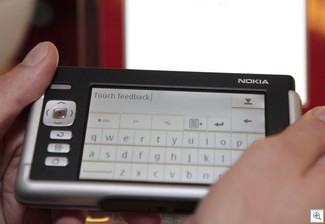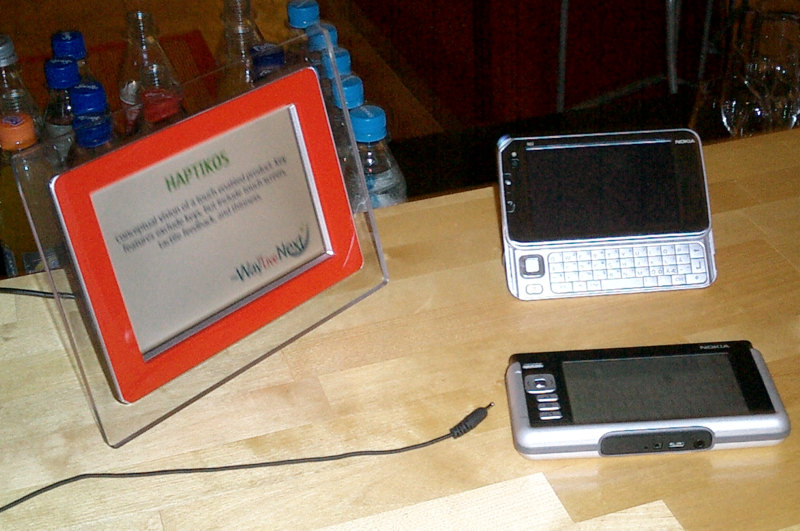
It’s taken them 10 years but Nokia boffins have finally perfected a ‘touch feedback’ touchscreen. Don’t be fooled by simple vibrational imitations folks, this is the real McCoy – you press a key on the screen, and it clicks under your finger with exactly the same sort of fingertip feedback as if you’d pressed a conventional keyboard key. Roope Takala, Senior Program Manager at Nokia’s research labs gave me a demo of the technology in Finland the other day on a hacked N770 Internet tablet.
“The basic technology is not that difficult,” he explained, “We inserted two small piezo sensor pads under the screen and engineered in a 0.1mm movement in the screen itself. What’s taken the time has been fine tuning the movement and response to mimic exactly the sensation of pressing a real key.”
The problem in perfecting the tech – codenamed Haptikos, meaning ‘to touch’ – lies in how our fingers experience a key press. We actually feel two movements, in and out, and these movements and the associated audio have to be perfectly attuned to the speed and responsiveness of a real keyboard. In use, the touch feedback on the demo device was near on perfect. Each press of a key returned a clunky click and tactile snap on the touchscreen, which made typing feel incredibly responsive and very usable on the smooth screen surface. In fact it was hard to remember that you were using a touchscreen keyboard.
“Funnily enough, although you think you’re typing faster than normal because of the feedback, in actual fact you’re not,” said Takala, “There’s just some sort of mental satisfaction that comes from typing with a tactile response.”
The new Haptikos technology will apparently be shipped with the upcoming Nokia S60 Touch phone that has been shown off at recent demos, and the team is busy working on the next challenge, which is to provide exact tactile replicas for scrolling and draw/paint programs. The problem is that while we expect and need ultra fast responses for keyboard use, navigation and things like drag scrolling require a different, slower response map, which is another hurdle for the engineers to overcome.
“What’s nice is that people who are new to handheld devices don’t even notice this technology at first,” says Takala with a smile. “But they really miss it if you take it away from them once they’ve experienced it. It’s kind of addictive.”
One thing I can say is that this is the first technology I’ve seen and played with which could genuinely revolutionise the use of handheld devices in general. The ability to touch type at reasonable speeds on a touchscreen is something which every phone, PDA and handheld computer manufacturer would give their right arm for, and it looks as though the technology is about to reach the marketplace with a bang. I can’t wait.
read more | digg story
Wednesday, November 7, 2007
Nokia perfects the clicky tactile touchscreen - iPhone gnashes teeth, swear
на
1:33 PM
![]()
Ярлыки: haptikos, iPhone, nokia, touchscreen
Subscribe to:
Post Comments (Atom)




No comments:
Post a Comment